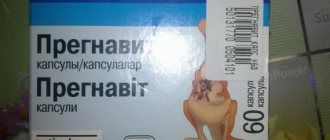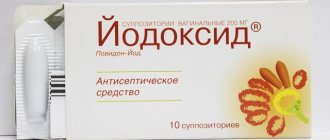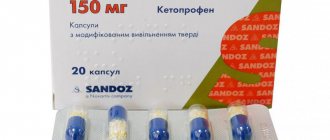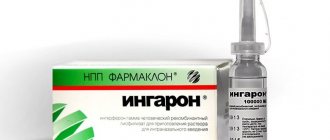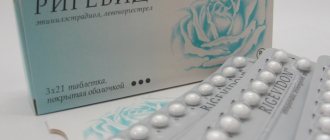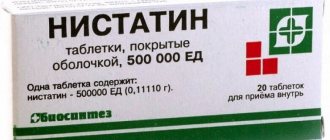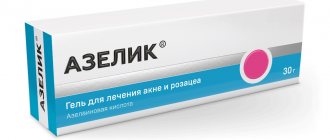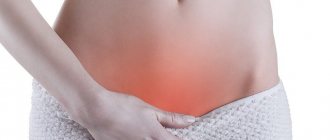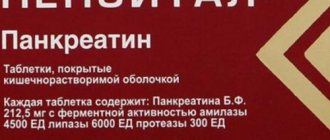The drug Chymotrypsin belongs to a group of proteolytic drugs obtained from the pancreas of cattle. The product has a pronounced anti-inflammatory, antiviral and healing effect. The medicinal composition has received widespread use as a remedy intended for the treatment of inflammatory and dystrophic infectious diseases of the respiratory tract, blood vessels and eyes.
pharmachologic effect
Chymotrypsin is a proteolytic drug of protein origin. When administered intramuscularly, the drug has an anti-inflammatory effect.
When used topically, the drug activates the process of breakdown of necrotic tissues, as well as fibrous type formations (blood clots, blood clots). The drug actively dilutes sputum, exudates, and blood clots.
During exposure to the components of the product, hydrolysis of proteins occurs and the process of breakdown of those compounds that formed amino acids .
Chymotrypsin actively affects the body in diseases of the respiratory tract, in which viscous sputum is formed.
Treatment effectiveness for skin lesions
Chymotrypsin is a drug of official medicine. So he went through randomized trials using control groups.
Before using a medicine, any medicine undergoes a series of clinical studies. It must meet the requirements for the effectiveness and safety of cleansing the body of necrosis.
The instructions indicate that the medication, when used topically, breaks down blood clots, blood clots, dead tissue, and wounds. Under the action of the enzyme, viscous sputum and esudates are liquefied.
According to the observations of doctors, when using Chymotrypsin against necrosis, on the second day the wound surface is cleansed, the severity of the inflammatory process and tissue hyperemia decreases. After a week, scarring begins. A more delicate and soft scar is formed than when using aggressive alcohol-containing antiseptics and hydrogen peroxide.
Indications for use
Chymotrypsin is prescribed to patients for the following diseases and conditions:
- periodontal disease in inflammatory-dystrophic form;
- thrombophlebitis;
- sinusitis;
- osteomyelitis;
- iridocyclitis, iritis;
- otitis;
- bronchitis , tracheitis ;
- cataract extraction.
Contraindications
People who have the following conditions or illnesses should not take this drug:
- intolerance to the components of the drug;
- decompensated forms of tuberculosis ;
- decaying malignant tumors;
- bleeding wounds;
- cirrhosis of the liver;
- infectious hepatitis;
- hemorrhagic diathesis;
- pancreatitis;
- emphysema ;
- heart failure;
- respiratory failure.
Side effects
The following negative effects are likely when taking Chymotrypsin:
- burning in the place where the product was applied;
- allergic manifestations;
- tachycardia;
- swelling and irritation of the conjunctiva;
- bleeding from healing areas;
- pain at the injection site;
- slight increase in body temperature.
During administration, substances with a histamine-like effect may be released into the cavities.
Precautions, contraindications and side effects
The drug for necrosis has an extensive list of contraindications, which are prescribed in the instructions. It is prohibited to use Chymotrypsin when cleaning wounds:
- heart failure in the stage of decompensation;
- emphysema;
- cirrhosis;
- degenerative processes in the liver;
- infectious hepatitis;
- pancreatitis;
- do not apply or inject into bleeding wounds or cavities;
- do not treat malignant tumors when they disintegrate;
- Tuberculosis is not an absolute contraindication, but the drug should be prescribed with caution. All activities are carried out on the basis of the medical institution.
Studies on the effect of Chymotrypsin against necrosis on the fetus, child, woman during pregnancy and lactation: FDA recommendations - category C. Use with caution during pregnancy and lactation in cases where the expected benefit outweighs the risk to the fetus or newborn.
According to the instructions, Chymotrypsin is well tolerated. The list of side effects from using cleaning with the drug is small:
- increased heart rate - tachycardia;
- hoarseness during inhalation administration;
- local reactions – pain, swelling;
- allergy;
- hoarseness;
- slight increase in temperature;
- tissue irritation.
After discontinuation of the enzymatic agent, the condition of the wound surface normalizes on its own.
Cases of overdose when cleansing the body of necrosis are not mentioned in the medical literature.
Chymotrypsin is approved for simultaneous treatment with antibiotics and mucolytics. Reduces the absorption of iron ions when used simultaneously with antianemic drugs. When using the enzyme, the prescription of antihistamines is indicated. Will help avoid the development of an allergic reaction.
The instructions indicate that the drug is not intended for intravenous administration.
Instructions for use of Chymotrypsin (Method and dosage)
The instructions for use of Chymotrypsin stipulate that initially, before use, it is necessary to dilute the product: for this, 0.005 g of powder should be diluted in 0.5-2% novocaine solution or 1-2 ml of isotonic sodium chloride . The resulting solution should be injected deeply into the gluteal muscle.
Adult patients should receive 0.0025 g once daily. As a rule, the course of treatment includes 6-15 injections. A more detailed treatment regimen should be prescribed by the attending physician individually.
For patients with respiratory diseases, Chymotrypsin is administered intramuscularly once a day at a dose of 5-10 mg. Therapy lasts from 12 to 14 days.
For the purpose of prevention and antibacterial treatment, pleural administration of 30 mg once a day is practiced.
Patients with thrombophlebitis need to take 10 mg of the drug intramuscularly for ten days.
When treating inflammatory phenomena and infectious diseases of the sensory organs, 1 ml of Chymotrypsin is instilled onto the mucous membranes with the addition of 1% novocaine twice a day.
The use of this medicine locally is carried out as follows: the product is applied to sterile napkins, after which the napkin must be applied to the site of the lesion or to a purulent wound. In this case, Chymotrypsin (20-40 mg) is used, dissolved in 10 ml of procaine . Therapy continues for ten days.
To prevent complications after operations, daily intramuscular injection of 5-10 mg of the drug is carried out. You need to start treatment 5 days before surgery, after which the medicine is administered for another 3-4 days.
In the case of purulent sinusitis, a solution of 5-10 mg of medication in 3-5 ml of saline solution should be injected into the maxillary cavity. For patients with otitis media, it is recommended to instill 0.5 - 1 ml of a 0.1% saline solution.
Composition and release form
The drug Chymotrypsin is a white powder for the preparation of a solution in sealed sterile bottles of 10 mg. The package contains 5 or 10 bottles.
Articles on the topic
- Chymotrypsin - instructions for use
- 15 cold powders for children and adults
- Antibiotics for children under one year of age - indications for use, dosage regimen
special instructions
It should be remembered when using Chymotrypsin that this is a remedy that cannot be applied to ulcerated malignant tumors, or inject the solution into bleeding cavities.
It cannot be administered intravenously.
If the drug is administered to people with severe tuberculosis, it should be done carefully, starting with very low doses. After taking antihistamines, you need to take a preventive course to remove them from the body.
People who drive vehicles or work with dangerous machinery during treatment with Chymotrypsin should be careful.
Analogs
Level 4 ATC code matches:
Ronidaza
Chymopsin
Collalysin
Trypsin
Iruksol
Ribonuclease
There are a number of similar drugs with the same active substance and similar pharmacological properties.
These medications are: Collalysin , Himopsin , Daltsex-Trypsin , Lysoamidase , Collitin , Pax-Trypsin .
There is also the drug Parapran with Chymotrypsin - a bandage for topical use.
Chymotrypsin price, where to buy
The price of Chymotrypsin averages from 490 to 550 rubles per 10 mg bottle.
- Online pharmacies in RussiaRussia
- Online pharmacies in UkraineUkraine
- Online pharmacies in KazakhstanKazakhstan
ZdravCity
- PARAPRAN wound stimulating dressing with chymotrypsin 7.5×10 cm. 30 pcs. Biotekfarm/New Dressings materials
1826 rub. order - Chymotrypsin lyof. for prig solution for in. 10 mg 10 pcs. Samson-Med LLC
968 RUR order
- “Parapran” dressing with chymotrypsin 5x7.5 cm 5 pcs. Biotekfarm/New Dressing materials
RUB 289 order
Pharmacy Dialogue
- Chymotrypsin (vial 10 mg No. 10) Samson-med LLC
RUB 889 order
show more
Pharmacy24
- Chymotrypsin 0.01 g No. 10 lyophilisate for the preparation of solution for injection TOV FZ BIOPHARMA, Ukraine / PrAT Biopharma, Ukraine
165 UAH order
PaniPharmacy
- Chymotrypsin ampoule Chymotrypsin crystalline pore. d/in 0.01g amp. No. 10 Ukraine, Biopharma CJSC
149 UAH order
show more
Properties of Chymotrypsin
Treatment of purulent-septic lesions of the skin and internal organs is a painful and difficult process for the patient and no less difficult for the doctor. Surgery with such wounds is to clean the damage from dead tissue. Chymotrypsin for necrosis is a proteolytic enzyme. The main thing is to correctly calculate the dosage of use and follow the instructions. The production of the enzyme substance occurs in the pancreas of every mammal on the planet.
For medical purposes, the enzyme is obtained from the pancreas of cattle. The body produces the drug in an inactive form. Under the influence of Trypsin, it is transformed into several forms with varying degrees of activity, which helps cleanse wounds from necrosis.
In medicine, a drug is used that is produced in the form of crystals. ATX code D03BA. It is not a unique development, it is produced by various pharmaceutical companies, and has instructions.
The use of the drug breaks down protein fractions into low molecular weight compounds, amino acids. Stable in the external environment, decomposes proteins more actively than other enzymes. Does not break down living tissue due to the presence of specialized antienzymes. This property allows the protein to be used to clean wound surfaces during purulent-septic processes.
Following the instructions, Chymotrypsin for necrosis is highly soluble in water and physiological solution with a pH close to neutral. The product is produced in sealed glass bottles of 5 ml containing 0.01 g of the active ingredient.
